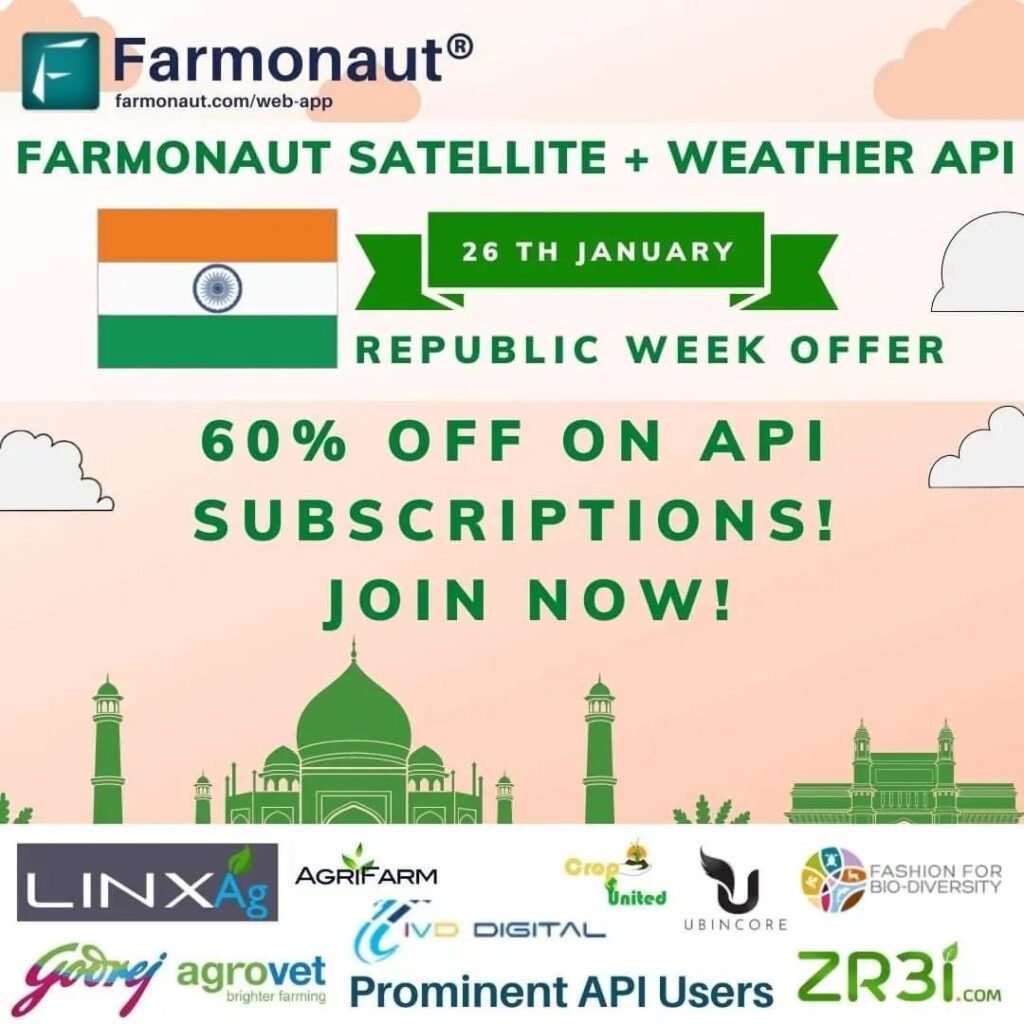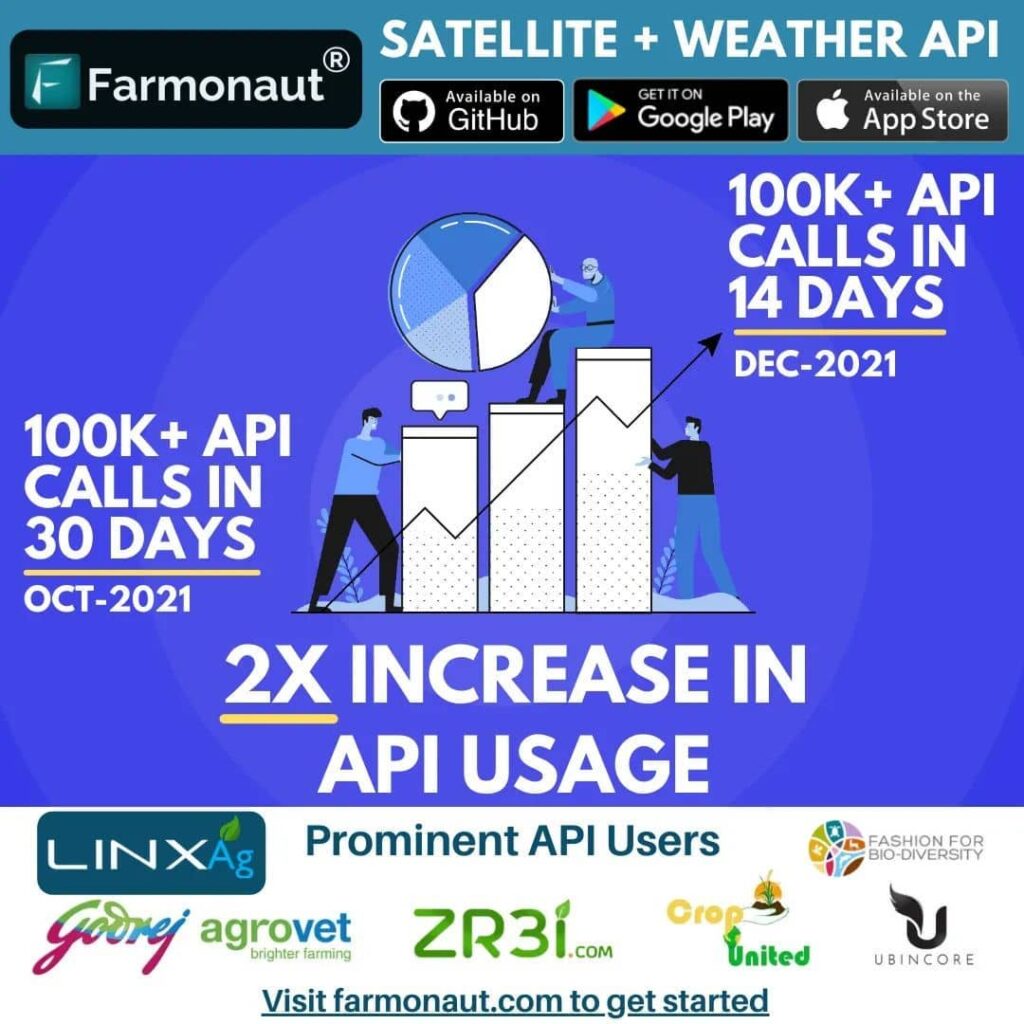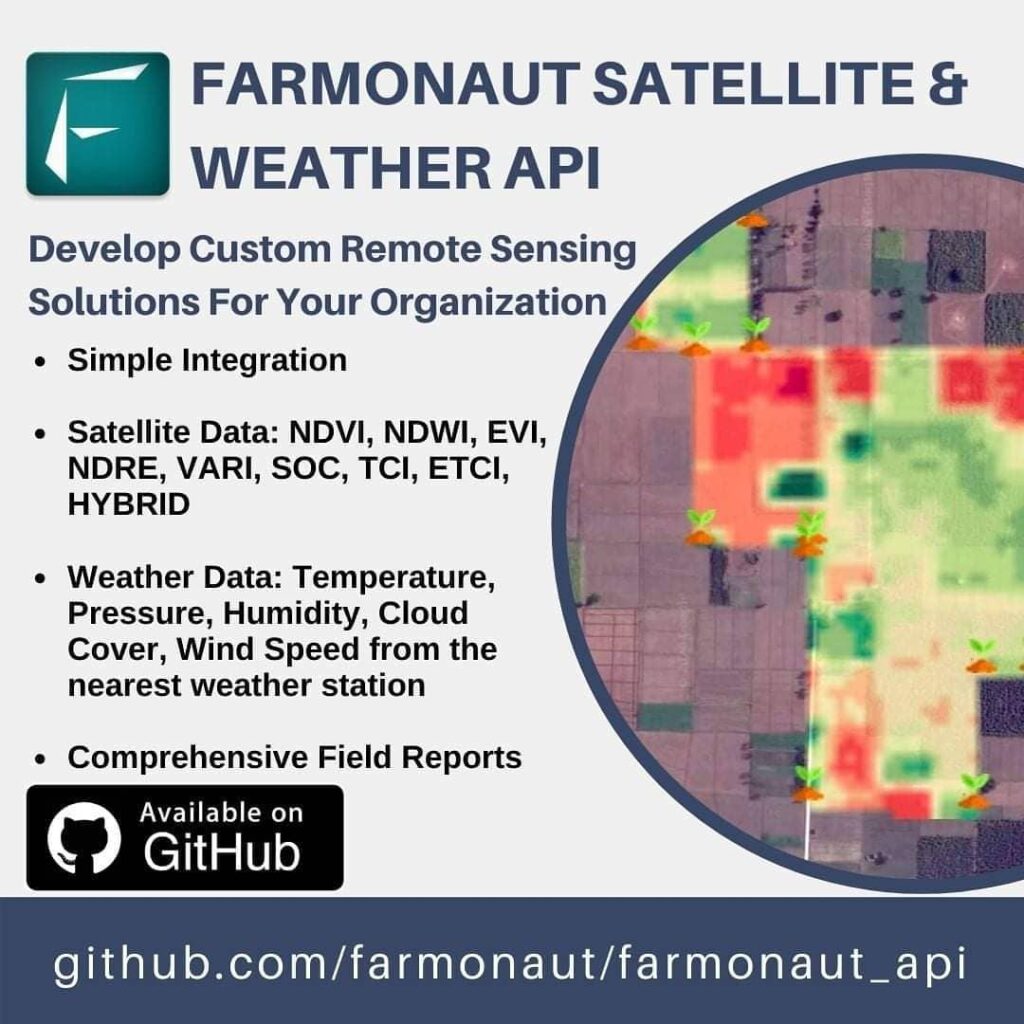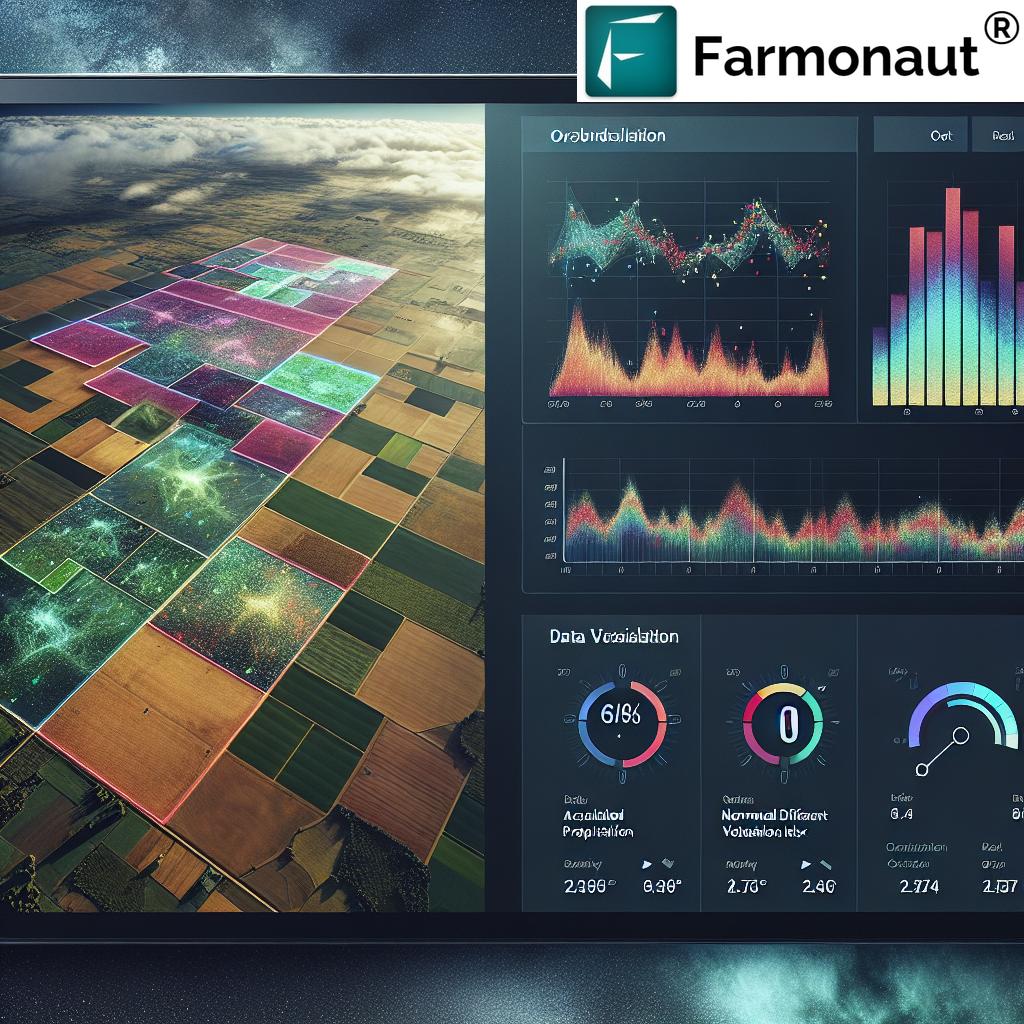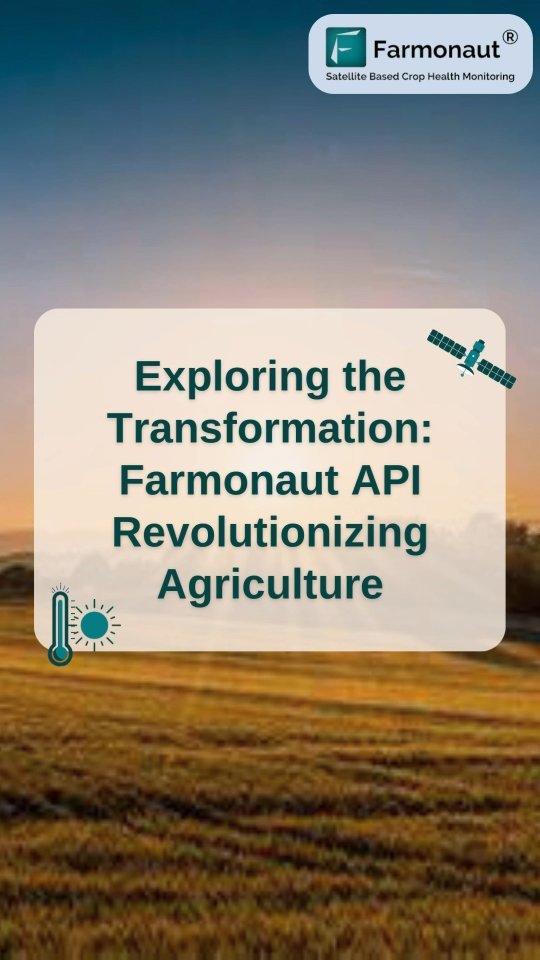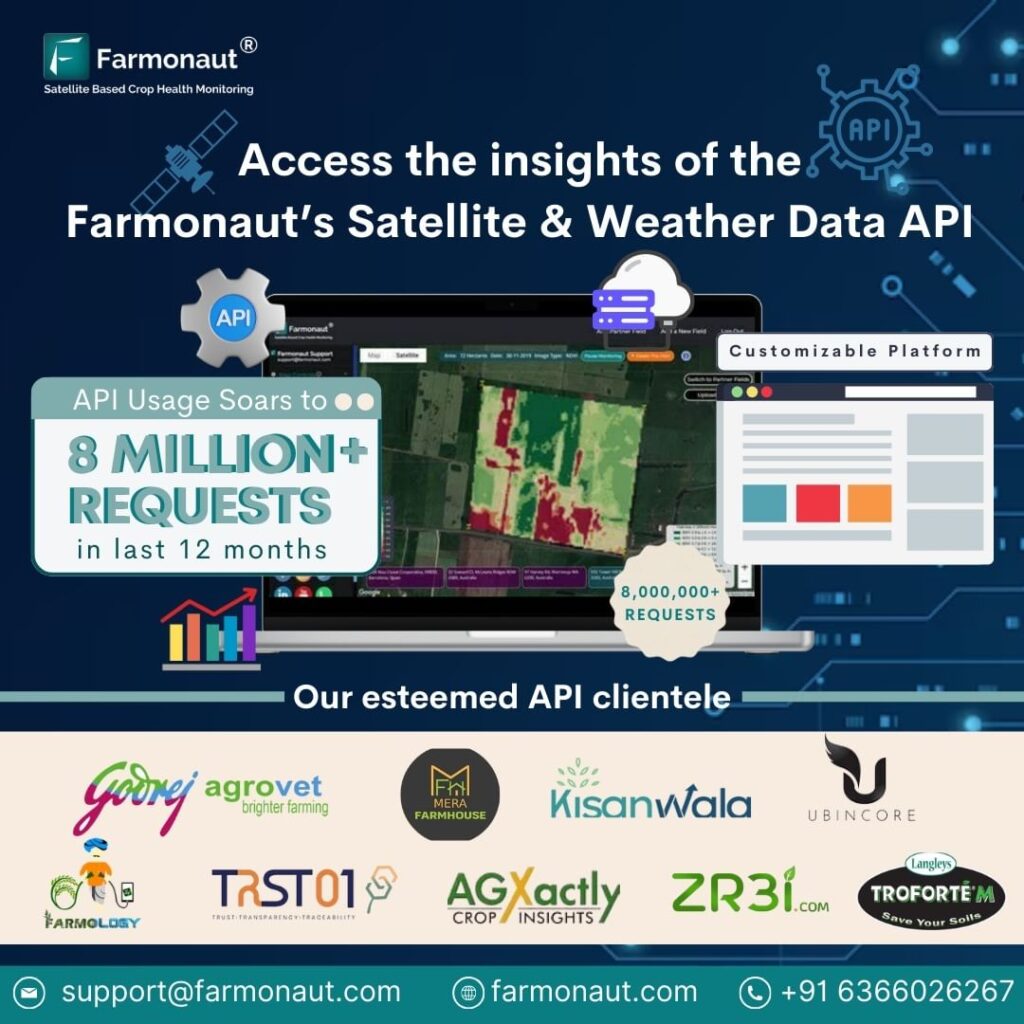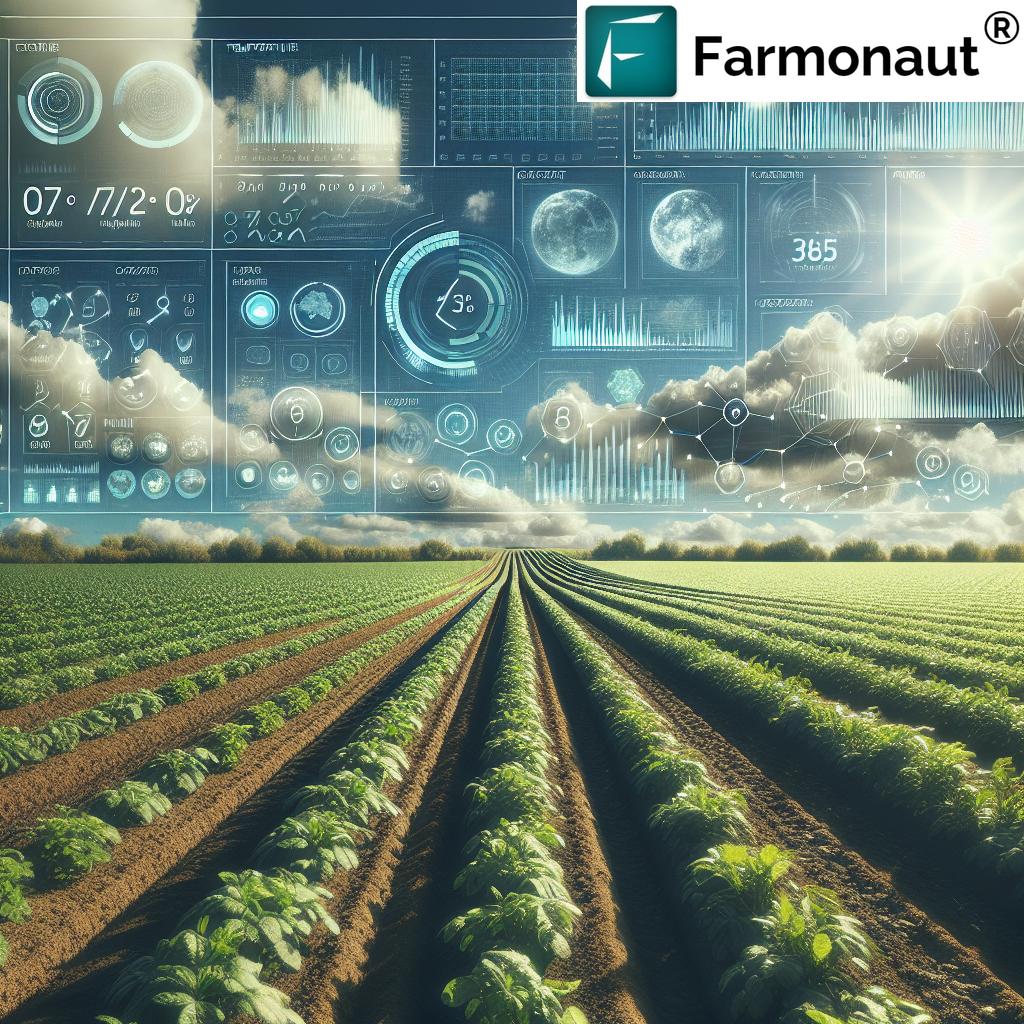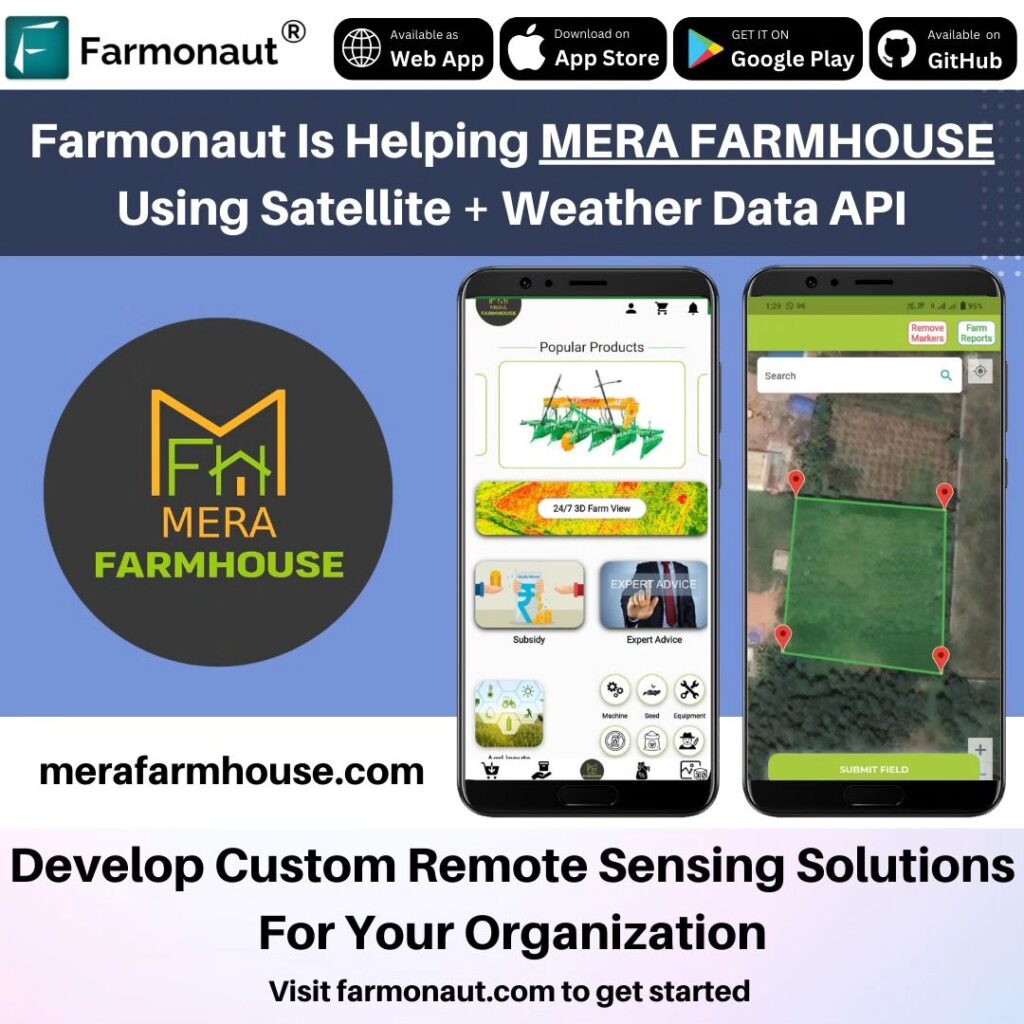Unlocking Affordable and Reliable Weather Data: Top Live and Open Weather APIs for Your Projects

In today’s data-driven world, access to accurate and timely weather information is crucial for various industries, from agriculture to renewable energy. At Farmonaut, we understand the importance of reliable weather data in making informed decisions, especially in the agricultural sector. In this comprehensive guide, we’ll explore some of the best weather APIs available, including live weather APIs, open weather APIs, and the cheapest weather APIs to help you find the perfect solution for your projects.
The Importance of Weather Data in Modern Agriculture
Before we dive into the world of weather APIs, let’s take a moment to understand why accurate weather data is so crucial, particularly in agriculture:
- Crop Planning: Farmers can make informed decisions about planting and harvesting based on long-term weather forecasts.
- Resource Management: Precise weather data helps optimize irrigation, fertilizer application, and pest control measures.
- Risk Mitigation: Early warnings of extreme weather events allow farmers to take preventive actions to protect their crops.
- Yield Prediction: Accurate weather data contributes to more reliable crop yield predictions, aiding in supply chain management and market planning.
At Farmonaut, we leverage advanced satellite technology and AI to provide farmers with real-time insights into their crop health and environmental conditions. Our platform integrates weather data with satellite imagery to offer a comprehensive farm management solution.
Understanding Weather APIs
An API, or Application Programming Interface, allows different software applications to communicate with each other. Weather APIs provide developers with access to weather data that can be integrated into various applications, websites, or systems. Here are some key features to look for in a weather API:
- Data Accuracy: The precision and reliability of the weather information provided.
- Update Frequency: How often the data is refreshed, with real-time or near-real-time updates being ideal for many applications.
- Historical Data: Access to past weather information for analysis and trend identification.
- Forecast Range: The duration of future weather predictions available.
- Global Coverage: The geographical areas covered by the API.
- Data Parameters: The range of weather metrics provided (temperature, humidity, wind speed, precipitation, etc.).
- Pricing: Cost-effectiveness and scalability of the API plans.
Top Weather APIs for Your Projects
Let’s explore some of the leading weather APIs that cater to various needs and budgets:
1. OpenWeatherMap API
OpenWeatherMap is one of the most popular open weather APIs available, offering a range of weather data services:
- Current weather data
- Minute forecast for 1 hour
- Hourly forecast for 48 hours
- Daily forecast for 8 days
- National weather alerts
- Historical weather data
Pricing: OpenWeatherMap offers a free tier with limited API calls, making it one of the cheapest weather APIs to get started with. Paid plans start at $40/month for more frequent updates and additional features.
2. WeatherAPI.com
WeatherAPI.com provides a comprehensive live weather API with global coverage:
- Real-time weather data
- 14-day weather forecast
- Historical weather data
- Weather alerts
- Air quality data
- Astronomy information
Pricing: WeatherAPI.com offers a free plan with up to 1 million API calls per month, making it an attractive option for developers looking for a cheap weather API with robust features.
3. Dark Sky API (now part of Apple)
While Dark Sky API is no longer accepting new signups, it’s worth mentioning due to its historical significance and the possibility of future integration with Apple’s weather services:
- Minute-by-minute forecasts for the next hour
- Hour-by-hour forecasts for the next 48 hours
- Day-by-day forecasts for the next week
- Observed weather data for the past decades
Note: As of March 31, 2023, Dark Sky API has been discontinued for existing customers. Developers are encouraged to explore alternative options.
4. AccuWeather API
AccuWeather is known for its accurate forecasts and offers a comprehensive API suite:
- Current conditions
- Daily and hourly forecasts
- Indices (UV Index, Air Quality, etc.)
- Severe weather alerts
- Historical weather data
Pricing: AccuWeather offers a free trial, with paid plans starting at $25/month for 50,000 API calls.
5. Weatherbit API
Weatherbit provides a robust set of weather data services:
- Current weather observations
- 16-day forecasts
- Historical weather data
- Severe weather alerts
- Agriculture-specific weather data
Pricing: Weatherbit offers a free tier with limited API calls, with paid plans starting at $35/month for increased limits and features.
Farmonaut’s Satellite Weather API: A Game-Changer for Agricultural Weather Data
At Farmonaut, we’ve developed our own Satellite Weather API, specifically designed to meet the unique needs of the agricultural sector. Our API combines satellite imagery with advanced weather modeling to provide highly accurate and localized weather data for farming applications.
Key Features of Farmonaut’s Satellite Weather API:
- High-resolution weather data tailored for agricultural use
- Integration with satellite-based crop health monitoring
- Historical weather data and forecasts
- Customized weather alerts for farming operations
- Soil moisture and evapotranspiration data
- API documentation and support for easy integration
To learn more about our Satellite Weather API and how it can benefit your agricultural projects, visit our API documentation page.
Comparing Farmonaut’s Satellite System with Drone and IoT-based Farm Monitoring
While drones and IoT devices have their place in agricultural monitoring, Farmonaut’s satellite-based system offers several advantages:
| Feature | Farmonaut Satellite System | Drone-based Monitoring | IoT-based Monitoring |
|---|---|---|---|
| Coverage Area | Large-scale (entire farms/regions) | Limited by flight time and regulations | Limited by sensor placement |
| Data Frequency | Regular updates (daily/weekly) | Dependent on flight schedules | Real-time, but localized |
| Initial Investment | Low (subscription-based) | High (equipment and training) | Moderate to High (sensors and infrastructure) |
| Maintenance | Minimal (managed service) | Regular (equipment upkeep, battery replacement) | Ongoing (sensor calibration, network maintenance) |
| Data Analysis | Advanced AI and machine learning | Requires specialized software and expertise | Varies based on platform capabilities |
| Weather Integration | Seamless integration with satellite weather data | Limited on-board weather sensing | Dependent on additional weather stations |
Choosing the Right Weather API for Your Project
When selecting a weather API for your project, consider the following factors:
- Data Accuracy and Reliability: Ensure the API provides accurate and up-to-date information from reliable sources.
- Coverage: Check if the API covers the geographical areas you’re interested in, especially for global or remote locations.
- Update Frequency: Determine how often you need the data to be updated. Some applications require real-time updates, while others can work with daily forecasts.
- Data Parameters: Make sure the API provides all the weather metrics you need for your specific application.
- Historical Data: If your project requires historical weather analysis, ensure the API offers access to past weather information.
- API Limits and Pricing: Consider your budget and expected usage. Look for APIs that offer flexible pricing tiers to accommodate your needs as your project grows.
- Documentation and Support: Good documentation and responsive customer support can significantly ease the integration process.
- Integration Ease: Look for APIs with SDKs or libraries in your preferred programming language to simplify integration.
Integrating Weather APIs into Your Projects
Once you’ve chosen a weather API, here are some steps to integrate it into your project:
- Sign up and obtain API key: Register for an account with the chosen API provider and obtain your unique API key.
- Read the documentation: Familiarize yourself with the API endpoints, request formats, and response structures.
- Make test requests: Use tools like Postman or cURL to make test API calls and understand the data format.
- Implement error handling: Ensure your application can handle API rate limits, network errors, and other potential issues.
- Cache data when appropriate: To reduce API calls and improve performance, consider caching weather data that doesn’t change frequently.
- Secure your API key: Never expose your API key in client-side code. Use server-side requests or environment variables to keep it secure.
- Monitor usage: Keep track of your API usage to stay within your plan limits and budget.
Use Cases for Weather APIs in Agriculture
Weather APIs can be integrated into various agricultural applications to improve decision-making and farm management. Here are some practical use cases:
- Irrigation Scheduling: Use weather forecasts and soil moisture data to optimize irrigation timing and amounts.
- Pest Management: Predict pest outbreaks based on temperature and humidity data to time pesticide applications effectively.
- Crop Planning: Use long-term weather forecasts to make informed decisions about crop selection and planting dates.
- Harvest Planning: Optimize harvest timing based on weather conditions to ensure crop quality and yield.
- Frost Protection: Set up alerts for potential frost events to protect sensitive crops.
- Yield Prediction: Combine weather data with crop models to forecast yields and plan for market demands.
- Resource Allocation: Use weather insights to optimize the deployment of farm equipment and labor.
At Farmonaut, we integrate weather data from our Satellite Weather API with our crop health monitoring system to provide farmers with comprehensive insights for better decision-making. Our platform allows farmers to:
- View real-time and forecasted weather conditions for their specific farm locations
- Receive custom alerts for weather events that may impact their crops
- Analyze historical weather patterns to inform long-term farm planning
- Correlate weather data with satellite-based crop health indicators for deeper insights
To experience the power of integrated weather and satellite data for farm management, try our Farmonaut app available on both Android and iOS platforms.
The Future of Weather APIs in Agriculture
As technology continues to advance, we can expect weather APIs to become even more sophisticated and integrated with other data sources. Some trends to watch for include:
- Increased Resolution: Higher spatial and temporal resolution in weather forecasts, allowing for more localized predictions.
- Machine Learning Integration: Advanced algorithms that can provide more accurate long-term forecasts and better interpret weather patterns.
- IoT Integration: Combining data from on-farm weather stations with larger weather models for hyper-local insights.
- Climate Change Modeling: Incorporation of climate change projections to help farmers adapt to long-term weather shifts.
- Crop-Specific Weather Indices: Development of weather indices tailored to specific crops and their growth stages.
At Farmonaut, we’re constantly innovating to stay at the forefront of these developments. Our team of agronomists, data scientists, and software engineers work together to ensure that our weather API and satellite monitoring systems provide the most valuable and actionable insights for farmers.
Conclusion
Access to reliable and affordable weather data is crucial for modern agriculture and many other industries. Whether you’re looking for a live weather API, an open weather API, or the cheapest weather API to get started, there are numerous options available to suit your needs and budget.
At Farmonaut, we’re committed to making precision agriculture accessible to farmers worldwide. Our Satellite Weather API, combined with our advanced crop monitoring technology, offers a comprehensive solution for farm management. By leveraging the power of satellite imagery, AI, and accurate weather data, we’re helping farmers make more informed decisions, increase productivity, and promote sustainable farming practices.
We invite you to explore our solutions and see how Farmonaut can transform your farming operations. Visit our API portal to learn more about integrating our weather and satellite data into your agricultural projects.
FAQs
-
Q: What is the difference between a live weather API and a standard weather API?
A: A live weather API provides real-time or near-real-time weather updates, often with minute-by-minute data. Standard weather APIs might update less frequently, such as hourly or daily. -
Q: Are open weather APIs always free?
A: Not necessarily. While some open weather APIs offer free tiers, they often have usage limits. More extensive usage typically requires a paid subscription. -
Q: How accurate are satellite-based weather APIs compared to ground-based weather stations?
A: Satellite-based weather APIs can provide high accuracy, especially for large areas or regions with limited ground-based stations. They often use a combination of satellite data and ground observations for optimal accuracy. -
Q: Can I use multiple weather APIs in my project?
A: Yes, some developers use multiple APIs to cross-verify data or to access different features. However, this approach may increase complexity and costs. -
Q: How often is Farmonaut’s weather data updated?
A: Farmonaut’s Satellite Weather API provides daily updates for most parameters, with some metrics available at higher frequencies depending on the subscription level.
Try Farmonaut Today
Ready to experience the power of integrated satellite and weather data for your farm? Subscribe to Farmonaut and unlock a new level of precision in your agricultural operations:
By choosing Farmonaut, you’re not just getting a weather API – you’re gaining access to a comprehensive farm management solution that combines the latest in satellite technology, AI-driven insights, and expert agricultural knowledge. Join us in shaping the future of sustainable and productive farming!





